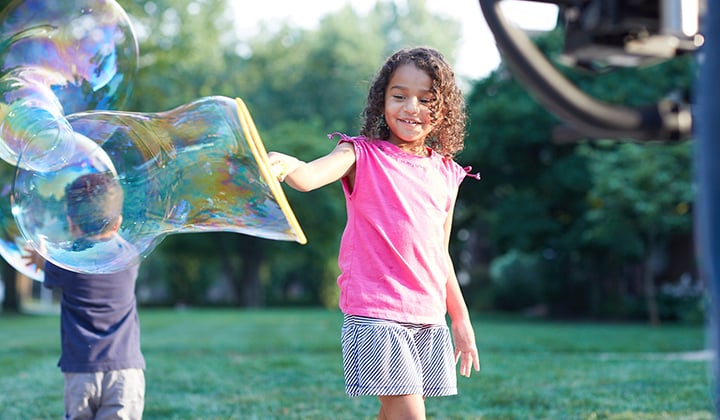It’s more than duck-duck-goose: how to encourage active play in preschoolers

We know staying active has so many benefits on your health and happiness. This is also true for our young family members, 3- to 5-year-old children. At this age, children are growing healthy bones and muscles, learning new skills, gaining coordination and their brains are developing quickly. There are lots of ways to help lay the groundwork at this early age that will help encourage kids to stay active later in life. And yes, even duck-duck-goose has a hidden learning purpose.
Why be purposeful in play?
Young children love to be active, especially when given the opportunity and encouragement! When children are active, they are learning! They are learning fundamental movement skills, like how to jump, throw and kick. When they play active games, not only do children improve their health, but kids also learn how to take turns, share and get along with others. Movement activities help children use several senses together, which can help activate their brains for learning. Last, but not least, active playtime together with the whole family can help build strong relationships with each other and even reduce stress.
How long should kids play daily?
Preschoolers should be active at least 3 hours a day which includes light, moderate and vigorous physical activities. National guidelines recommend reducing time spent just sitting and keeping young children moving throughout the day to enhance growth and development.
What kind of play?
With children as young as 3, 4 and 5 we’re definitely not asking to lift weights or do a training session. At this age, their physical activity is always wrapped up in fun! It should be both unstructured and structured.
- Unstructured active play can include playground activities, kicking a ball, dancing, riding a tricycle, jumping, skipping, hopping, etc. All these types of activities can help strengthen bones. We’re just wanting kids to find joy in movement and play at this age.
- Structured active play is led by adults and can include family walks, playing games like duck-duck-goose, red-light green-light and chasing bubbles. These activities may not have many complex rules or last very long but can teach turn-taking, communication and rule-following, as well as having the important physical health benefits of physical movement.
Ways to encourage active play
- Explore nature. Summer is a wonderful time for active play. Being outside, as weather permits, allows children opportunities to run, climb and explore in active play. Even young children can join the whole family on short hikes or exploring of outdoor parks and green spaces. If it’s hot, try to get out in the morning or evenings for outside activities or family walks when the weather is cooler. Find a great Kansas City area family-friendly trail here.
Check out your local city or county parks and recreation department for parks, playgrounds, pools and trails near you. For example, KC Parks has a way to search by age group and type of attraction like parks, spray grounds, pools, hiking trail and others.
- Splash around. Water activities are a great way to stay cool and active in the summer heat. Even if access to a swimming pool or splash pad is limited, running through a sprinkler or tossing water balloons can be fun for young children. Even using low-cost sponge balls or sponges in a bucket of water, children can enjoy getting wet while tossing their "water balls."
- Make inside fun. Children can be active even when they are indoor as well. You can choose a safe play area and try some active inside games, like creating an obstacle course with chairs, boxes and toys for the kids to go over, under, through and around. Using soft balls, balloons or light scarves for indoor throwing can get kids moving, hopping and laughing. Even young children can help with some active chores, such as putting groceries away or helping with watering plants or a garden in the summer.
- Keep fun in the routine. Transitions and wait times can be transformed into fun active time by hopping like a bunny to the car or practicing standing on one leg, like a flamingo while waiting in line. Storytime can include movement through acting out the action, characters or animals.
- Model staying active. Family time can include your family’s favorite ways to be active together like family walks, dance parties and active games your family enjoys. Making physical activity the default for family time can benefit everyone and set a positive example for young children.
- Ask your child’s program. If your child is in a summer camp or early care and education program, ask the teacher or director about how often children go outside, how many opportunities there are for unstructured active play, as well as a structured physical activity led by teachers, and how they include movement in learning activities. They may even have ideas of what activities your child is most interested in during the day to be active that you can use at home too. Recently, the first-ever Kansas City Physical Activity Plan prioritized early childhood physical activity in early care and education settings and encourages our Kansas City community to support programs in including more active playtime throughout the day.
